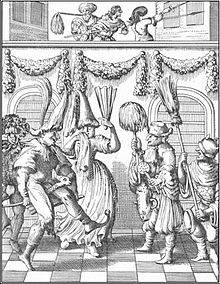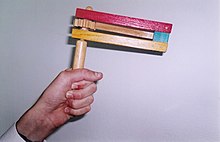Purim
![]()
This article is about the Jewish festival. For the Brazilian jazz singer of the same name, see Flora Purim.
The festival of Purim (Hebrew ![]() purim, plural of פור pur, German 'Los, Schicksal', originally from the Akkadian word pūru Yiddish Purim or Pirem) is a Jewish festival commemorating the salvation of the Jews in the Achaemenid Empire.
purim, plural of פור pur, German 'Los, Schicksal', originally from the Akkadian word pūru Yiddish Purim or Pirem) is a Jewish festival commemorating the salvation of the Jews in the Achaemenid Empire.

Purim celebrants in costume, print from the Philologus Hebræo-Mixtus, 1657.
Source
Purim is a festival that commemorates the salvation of the Jewish people from imminent danger in the Persian Diaspora. According to the Book of Esther, Haman, the Persian king's highest government official, attempted to murder all the Jews in the Persian Empire of the time in one day. His name thus became a symbol of hostility to the Jews. Queen Esther, however, brings about salvation through fasting and prayer.
The Book of Esther describes Haman as having selfishly exploited his office as the highest government official of the Persian king Achashverosh (Hebrew for Xerxes I). The royal servants had to kneel before him. However, Ester's cousin and adoptive father Mordecai, as a Jew, had refused. In revenge, Haman is said to have decided to kill all the Jews. The exact date, the 13th of Adar, was determined by lot - hence the name Purim ("lots"). Ester, the queen, however, is said to have interceded with the king, at the risk of her life, to save the Jews, whom he then allowed to defend themselves. Haman was killed together with about 75,000 other inhabitants of the Persian Empire.
There is possibly a connection here with the Zoroastrian festival frawardīgān, which is reported by Herodotus, among others, as magophonia-the "murder of the Magians" (3.68-79)-and on which the Zoroastrian Persians commemorated the reign of the Magian Gaumata and the subsequent rise of Darius I.
_-_Aert_de_GELDER_-_Google_Cultural_Institute.jpg)
Ester and Mordecai

The triumph of Mordecai
Day of the celebration
Purim is celebrated on the 14th or 15th day of the month of Adar on the Jewish calendar. It is a holiday in Israel.
| Jewish Year | Gregorian date |
| 5781 | 26 February 2021 |
| 5782 | 17 March 2022 |
| 5783 | 7 March 2023 |
| 5784 | 24 March 2024 |
| 5785 | 14 March 2025 |
When Purim falls on a Friday, the celebrations last for three days.
Every feast day begins on the eve, because in the Jewish calendar the day lasts from the eve to the evening of the day - not from 0 to 24 o'clock. The evening beginning is designated by the word Erev (Hebrew ערב evening).
Throughout Israel and the Diaspora, the Feast of Purim is celebrated on the 14th of Adar. In Jerusalem and in Jericho, as in the then (Persian) capital of Susa, as well as in all the cities that were surrounded by a wall in the time of Joshua son of Nun, the festival of Purim is celebrated on the 15th of Adar. This Purim is called Shushan Purim, or Purim of the cities, on account of the fact that it is celebrated only in the cities formerly surrounded by a wall, - in contrast to Purim of the provincial cities, which is celebrated in open cities. In cities where there is doubt as to the date of their origin and walls around them - e.g. Acre, Tiberias, Jaffa - Purim is celebrated on both the 14th and 15th of Adar.
The reason is this: On the 13th of Adar the Jews fought a battle of salvation and redemption against their enemies, and on the 14th of Adar they rested from it. Therefore, this day is considered a day of joy and feasting. In contrast, the Jews in the capital city of Susa were given permission to fight against their enemies on both the 13th and 14th of Adar, and it was not until the 15th of Adar that they rested from the fighting. Therefore, the 15th of Adar was set aside as the day of rejoicing for the Jews in the capital. In order to honor the Land of Israel, which at that time was desolate and empty, the Jewish scholars decided to transfer some of the uniqueness of the capital city of Susa also to the cities in the Land of Israel, which at the time of Joshua were surrounded by a wall.
In Jewish leap years, Adar is doubled; Purim in this case takes place in the second Adar and Purim qatan (little Purim) is then celebrated in the first Adar. Unlike in Rabbinic Judaism, the Karaites celebrate Purim in the first Adar.
Purim meschulasch
Purim meshulash (three times Purim): It may be the case that the festival of Purim lasts for a total of three days, namely when the 15th of Adar falls on a Sabbath in a walled city. Then the following applies:
- 14 Adar: Reading of the Megillah and gifts for the poor,
- 15 Adar (Sabbath): Prayer Al ha-Nissim, reading of the Torah,
- 16 Adar: Feast and sending gifts to those close to you.

Ratchet for Purim
.JPG)
Hamantaschen with poppy seeds
.JPG)
Purim Festival in Dresden 2016
Search within the encyclopedia